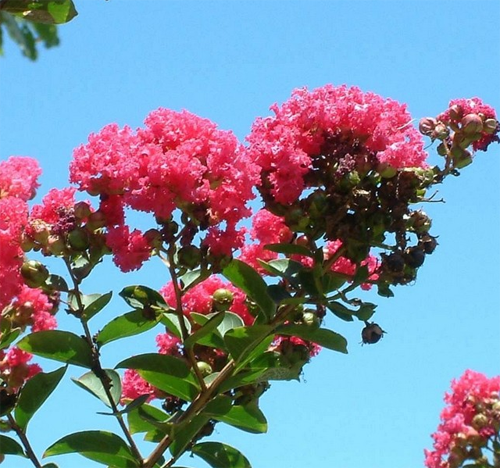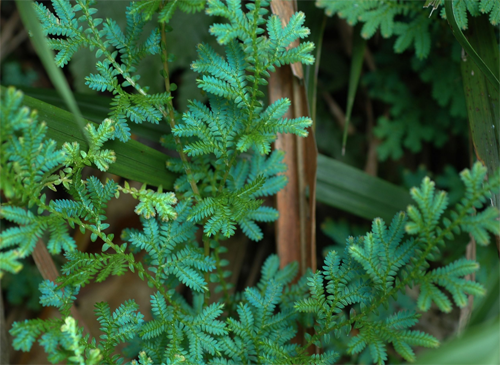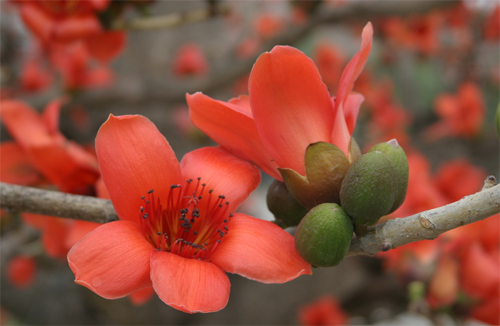How to plant and propagate crape myrtle and control of diseases and insect pests
Crape myrtle flowers grow that is very good-looking, blooming flowers that is a string, is very attractive, how to plant crape myrtle flowers? What are the breeding methods of crape myrtle? In the process of breeding crape myrtle flowers, how to prevent and control diseases and insect pests?

How to grow crape myrtle:
1. Lighting
It likes the sunny environment, whether it is ground planting or bonsai need enough light in order to grow better.
2. Proper watering
It likes the warm and moist environment, although it is more resistant to drought, but it can be replenished properly in the rainy season, especially bonsai, it can be watered in the morning and evening in summer and autumn, and increased watering in hot days.
3. Rational fertilization
Potted crape myrtle should not be fertilized too much, or it will grow weaker, so you need to apply a small amount of fertilizer regularly, a little more in spring and summer, less fertilizer in autumn, no fertilization in winter, and less fertilizer in winter.
4. Reasonable pruning
Crape myrtle as a common green tree, it is very resistant to pruning, easy to new branches, but also to remove the residual flowers after flowering, in order to let the new flowers grow again and reduce consumption. Usually diseased branches and weak branches should be pruned in time to avoid excessive consumption of nutrients.
5. the time to change the basin
Potted crape myrtle does not need to change pots frequently, usually once every 2 to 3 years. Potted soil is mixed with ordinary loose humus soil and garden soil, with 2 or 3 equal parts of river sand.
Of course, you need to add the right amount of organic fertilizer, mature cake fertilizer, these can be used as base fertilizer, but can not directly contact the root system, will hurt the root.
The propagation method of crape myrtle:
Crape myrtle propagation is generally cutting propagation, can also be sown or striped propagation, if you want more interesting things, you can try grafting, so that a tree to produce different varieties, different colors of flowers.
1. Cutting
Hard branches (branches longer than a year) are generally cut after spring warmth. Strong branches are selected, cut into 15cm-long cuttings, inserted into loose and well-drained sandy soil, watered and covered with plastic film to keep moisture and heat preservation.
Softwood cuttings are carried out in summer. Semi-lignified branches are selected and cut into 8~10cm length, leaving 2-3 leaves in the upper part. The cuttings are watered and covered with shade, and the survival rates of these two kinds of cuttings are good.
2. Sowing seeds
Mature seeds can be collected at the end of autumn, peeled, dried, and sown after the next spring is warm.
3. Grafting
In fact, there are several varieties of crape myrtle, such as silver myrtle, its flowers are white, Cuiwei's flowers are blue-purple, lavender; red flowers are pink and crimson; the survival rate is very high, in late winter and early spring, before crape myrtle sprouts.
Disease control of crape myrtle:
1. Powdery mildew
It is necessary to prune properly in winter, cut off diseased branches and withered branches, and remove weak branches and diseased leaves in time in spring; when you get sick, you can spray rutin, methyl topiramate and Dysen zinc, and there must be more than two kinds of drugs used alternately to avoid disease resistance.
2. Coal pollution disease
If the growth is luxuriant, the diseased branches should be pruned properly, ventilation and light transmission should be good in order to reduce the incidence of the disease; the disease can be sprayed alternately with methyl topiramate and carbendazim.
3. Aphids, shell insects and other insects
You can spray omethoate or dichlorvos. The key to maintenance is to prune more in winter and early spring and get rid of weak and diseased branches in order to reduce diseases and pests.
The alias of crape myrtle:
Hundred-day red, full red, very common in all parts of our country, its color is very bright, the number of flowers is rich, and the florescence is so long that it can be seen in summer and autumn.
Crape myrtle breeding methods and breeding methods are introduced here, do not quickly breed in their own home, so that their own home more beautiful.
What is the breeding method of potted crape myrtle
Crape myrtle, also known as itching flower, itching tree, purple golden flower, etc., is a deciduous shrub or small tree of the genus Lagerstroemia of the family Lycopodiaceae. It has been cultivated in China for thousands of years and is widely planted as an ornamental tree species. Let's take a look at how to raise potted crape myrtle!
How to raise potted crape myrtle flowers:
1. Soil: crape myrtle has strong vitality, easy to cultivate, lax requirements on soil, likes to grow on fertile and moist soil, and can endure drought. No matter calcareous soil or acidic soil grows well, it grows well in slightly moist land, and grows best when planted in deep and fertile sandy loam.
2. Watering: crape myrtle is resistant to drought and waterlogging. It can be watered with green water and frozen water once a year before spring germination and after falling leaves in autumn. Usually, if it is not too dry, it is not necessary to water it. Generally, water should be watered for 1 or 3 times during spring drought. Waterlogging should be done well in the rainy season to prevent water from rotting roots. It is not suitable to water in autumn.
3. Sunshine: crape myrtle bonsai is happy and generally grows under the condition of sufficient sunshine and good ventilation. In winter, the southern region can spend the winter in the outdoor leeward and sunny place, while the northern area should move indoors. Lack of light is not only lack of flowers or no flowering, but also weak growth, small branches and leaves, so it is necessary to put crape myrtle in the outdoor sun during the growing season.
4, temperature: crape myrtle is not cold-resistant, easy to freeze and dry, and will freeze to death when it is serious, so it should be moved indoors in winter, room temperature should be kept above 7 ℃, and plastic bags should be used for heat preservation, hot water heating, furnace fire heating and other methods should be adopted when the temperature is less than 7 ℃. And should pay attention to ventilation, indoor temperature is too high, can open doors and windows, reduce water, otherwise affect its normal dormancy, or even rotten roots.
5. Fertilization: crape myrtle is a fertilizer-loving plant, lack of fertilizer will lead to thin branches and yellow color, resulting in weaker growth, less or no flowering, but excessive fertilization will lead to excessive growth of branches and leaves. Can be fertilized every year after the defoliation of crape myrtle flowers in winter and before germination in spring, such as the application of human feces and urine or sesame sauce residue is better, can make crape myrtle flowers grow exuberantly in the coming year, the flowers are big and colorful.
6. Pruning: the inflorescence of crape myrtle is born at the top of the new branch of the year, so it is necessary to re-prune the annual branch when pruning, so that the nutrients are concentrated and the branches are strong, and the long branches, dry and withered branches, drooping branches, disease and insect branches, slender branches and endophytic branches should be cut off, and the lateral branches in the lower part of the plant trunk should be cut off in time in the young tree stage, so that the upper part of the trunk can get sufficient nutrients and form a good crown.
7. Insect pests: crape myrtle is vulnerable to shell insects under the condition of insufficient light and poor ventilation, and can also cause coal fouling disease. Scale insects can be sprayed with 1000 times of dimethoate EC or poisoned with 3% Fangludan granular soil. Aphids and powder aphids are often harmed in Meiyu, which can be sprayed with 40% dimethoate diluted to 1500 times or 80% dichlorvos emulsion with 1000 to 1200 times. Coal pollution disease can be prevented and treated with stone-sulfur mixture.
8. Change the basin: potted crape myrtle needs to change the basin soil every two to three years. 5% loose mountain soil, 3% pastoral soil and 2% fine river sand are mixed into culture soil. when changing the basin, you can use bone powder, bean cake powder and other organic fertilizer as the base fertilizer, mixed in the surface layer of the soil, so that the fertilizer can not be in direct contact with the root system, so as not to burn the root system and affect plant growth.
Growth habits of crape myrtle:
Crape myrtle like warm and humid climate, like light, slightly resistant to shade, like fertilizer, especially like deep and fertile sandy loam, born in slightly humid places, but also resistant to drought, avoid waterlogging, avoid planting in low humid places with high groundwater level, warm, cold-resistant and strong sprouting. It has strong anti-pollution ability and strong resistance to sulfur dioxide, hydrogen fluoride and chlorine. Semi-shady, happy to be born on fertile and moist soil, can also tolerate drought, no matter calcareous soil or acid soil grows well.
The propagation method of crape myrtle:
1. Grafting propagation: from late February to early March, the shoots of crape myrtle were carried out before sprouting, and the sturdy seedlings were selected as rootstocks, and the branches of the desired flowers and colors were taken as scions. First, cut longitudinally at the top of the rootstock against the outer part, about 5cm to 8cm deep, then cut the scion with more than 2 buds into a wedge and insert the split of the rootstock at the cambium. Then wrap the whole spike branch with plastic film to reveal the bud.
2. Hardwood cuttings are generally carried out before the branches germinate from mid-late March to early April. Select sturdy annual branches, cut into cuttings 15 cm long, insert into loose, well-drained sandy soil seedbed, cuttage depth to expose the uppermost bud of the cuttings. After insertion, pour through water and cover with plastic film to keep moisture and heat preservation. When the seedling grows into 15 cm to 20 cm, the film can be lifted, changed into a shade net, and watered at the right time, and the branches can grow to about 60 cm to 80 cm in that year.
3. Softwood cuttings were carried out from July to August, when the new branches grew vigorously and had the most vitality. Choose semi-lignified branches and cut them into cuttings 8 cm long and 10 cm long, leaving 2-3 leaves at the top. The cutting depth is 3cm to 4cm. After insertion, pour through water, and build a shade shed to shade, generally take root in about 20 days, remove the film, retain the shade net, and then timely watering, the branches can grow to about 60-80 cm in that year, and the survival rate is very good.
4. Striping propagation: striping propagation is better from March to April in spring, 1-2-year-old branches can be selected, cut with a sharp knife and peel the bark around 1.5 cm, expose xylem, apply rooting powder solution (diluted according to instructions) to about 3 cm above the burn site, cover it with barrel-shaped plastic bags after drying, fill it with loose garden soil, tie both ends tightly after watering, and check after a month. If the soil is too dry, it can be watered and moisturized. Cut off and replant after taking root.
5. Meristematic propagation: the tiller seedlings germinated in the rhizosphere of the plant were dug up with roots from March to early April or autumn, and the roots and branches were properly trimmed and planted separately. Seedlings can be bare roots, large seedlings should bring mud balls, tending should be often pruned, plastic, maintain a beautiful tree shape, promote flower branches to flourish.
6. Sowing and propagation: usually sow or sow broad strips on the seedling bed of sandy soil in March, cover with a layer of fine charred mud, and cover the grass with no seeds. After more than 10 days, the weeds can be uncovered in time. When two pairs of true leaves appear in the seedlings, they can choose the seedlings after rain, weed them frequently at the seedling stage, apply thin fertilizer 2 or 3 times from June to July, irrigate and prevent drought in summer, and the seedling height at the end of the year is about 40-50cm. The seedlings with strong growth can blossom in the same year, should be cut off in time, and the Spring Equinox transplant and grow up the next year.
Common insect pests and control methods of crape myrtle
Symptoms of APHIS gossypii in crape myrtle
Every year, 5-8 generations occur in the north, overwintering with eggs, the initial stage of the disease is in May, and June is the peak of the disease. Aphids will suck juice, harm young leaves, and pose a threat to the growth of crape myrtle.
Prevention and cure method
In early spring, scrape off the old bark of crape myrtle, cut off the damaged branches and burn them centrally in order to eliminate the overwintering eggs as much as possible. Cultivation management should be strengthened in peacetime maintenance in order to reduce the source of disease.
When aphids are serious, you can choose spray fish rattan essence 1000-2000 times or 40% omethoate, 40% acephate 1000-1500 times to eliminate, but also pay attention to avoid drug damage. Where there are conditions, artificial breeding and releasing natural enemies can also be taken, and scattered breeding of discolored lady beetles or grass ridge larvae is a good choice. In addition, color swatches can also be used to trap and kill aphids with wings or aphids that reflect light with white tin paper and refuse to live and migrate.
Symptoms of crape myrtle crape myrtle
Two generations occur every year, overwintering with eggs or nymphs. Female adults and nymphs often suck juice on crape myrtle bud axils, leaves and branches, resulting in blackening of branches and leaves and shedding leaves, which is not conducive to the growth of crape myrtle. In addition, the feces of the pest can also induce coal fouling disease, which has a high potential risk.
Prevention and cure method
In winter and early spring, prune the branches, burn them centrally, destroy the eggs as far as possible, and artificially scrape the pests found. Strengthen management and quarantine, reasonable fertilization, in order to enhance the plant insect resistance, at the same time avoid excessive plant density, maintain plant ventilation, and do a good job of light transmission. You can use polymer film to mix spray, and then spray evenly, which will form a thin film on the surface of the plant, which will cause difficulty in breathing and suffocate to death, or use its natural enemy, red lip mark worm, to prey and destroy. Chemical control can also be taken if necessary.
- Prev

How does the cloud grow yellow?
Green grass this plant is also quite characteristic, leaves are blue, or better confirmed, because most of the leaves of plants are green, green grass how to raise it? What if the leaves turn yellow in the process of breeding? How do you make a cloud of dust? -The cloud of dust is a cloud of dust.
- Next

The culture method of kapok and how long is its propagation and flowering period
Kapok that is a lot of people like, think that there is a TV series called kapok spring, watching this TV series, needless to say, the tears have been flowing, kapok breeding and breeding methods are what? How long is the florescence?
Related
- Fuxing push coffee new agricultural production and marketing class: lack of small-scale processing plants
- Jujube rice field leisure farm deep ploughing Yilan for five years to create a space for organic food and play
- Nongyu Farm-A trial of organic papaya for brave women with advanced technology
- Four points for attention in the prevention and control of diseases and insect pests of edible fungi
- How to add nutrient solution to Edible Fungi
- Is there any good way to control edible fungus mites?
- Open Inoculation Technology of Edible Fungi
- Is there any clever way to use fertilizer for edible fungus in winter?
- What agents are used to kill the pathogens of edible fungi in the mushroom shed?
- Rapid drying of Edible Fungi

